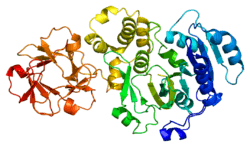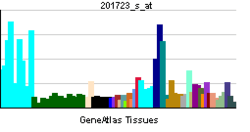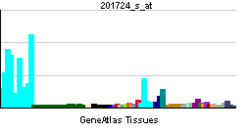GALNT1
| View/Edit Human | View/Edit Mouse |
Polypeptide N-acetylgalactosaminyltransferase 1 is an enzyme that in humans is encoded by the GALNT1 gene.[3][4][5]
This gene encodes a member of the UDP-N-acetyl-alpha-D-galactosamine:polypeptide N-acetylgalactosaminyltransferase (GalNAc-T) family of enzymes. GalNAc-Ts initiate mucin-type O-linked glycosylation in the Golgi apparatus by catalyzing the transfer of GalNAc to serine and threonine residues on target proteins. They are characterized by an N-terminal transmembrane domain, a stem region, a lumenal catalytic domain containing a GT1 motif and Gal/GalNAc transferase motif, and a C-terminal ricin/lectin-like domain. GalNAc-Ts have different, but overlapping, substrate specificities and patterns of expression. Transcript variants derived from this gene that utilize alternative polyA signals have been described in the literature.[5]
References
- ↑ "Human PubMed Reference:".
- ↑ "Mouse PubMed Reference:".
- ↑ White T, Bennett EP, Takio K, Sorensen T, Bonding N, Clausen H (Dec 1995). "Purification and cDNA cloning of a human UDP-N-acetyl-alpha-D-galactosamine:polypeptide N-acetylgalactosaminyltransferase". J Biol Chem. 270 (41): 24156–65. doi:10.1074/jbc.270.41.24156. PMID 7592619.
- ↑ Tenno M, Toba S, Kezdy FJ, Elhammer AP, Kurosaka A (Aug 2002). "Identification of two cysteine residues involved in the binding of UDP-GalNAc to UDP-GalNAc:polypeptide N-acetylgalactosaminyltransferase 1 (GalNAc-T1)". Eur J Biochem. 269 (17): 4308–16. doi:10.1046/j.1432-1033.2002.03123.x. PMID 12199709.
- 1 2 "Entrez Gene: GALNT1 UDP-N-acetyl-alpha-D-galactosamine:polypeptide N-acetylgalactosaminyltransferase 1 (GalNAc-T1)".
Further reading
- Paulson JC, Colley KJ (1989). "Glycosyltransferases. Structure, localization, and control of cell type-specific glycosylation.". J. Biol. Chem. 264 (30): 17615–8. PMID 2681181.
- Bennett EP, Hassan H, Clausen H (1996). "cDNA cloning and expression of a novel human UDP-N-acetyl-alpha-D-galactosamine. Polypeptide N-acetylgalactosaminyltransferase, GalNAc-t3.". J. Biol. Chem. 271 (29): 17006–12. doi:10.1074/jbc.271.29.17006. PMID 8663203.
- Meurer JA, Naylor JM, Baker CA, et al. (1996). "cDNA cloning, expression, and chromosomal localization of a human UDP-GalNAc:polypeptide, N-acetylgalactosaminyltransferase.". J. Biochem. 118 (3): 568–74. PMID 8690719.
- Meurer JA, Drong RF, Homa FL, et al. (1996). "Organization of a human UDP-GalNAc:polypeptide, N-acetylgalactosaminyltransferase gene and a related processed pseudogene.". Glycobiology. 6 (2): 231–41. doi:10.1093/glycob/6.2.231. PMID 8727794.
- Takai S, Hinoda Y, Adachi T, et al. (1997). "A human UDP-GalNAc: polypeptide, N-acetylgalactosaminyltransferase type 1 gene is located at the chromosomal region 18q12.1.". Hum. Genet. 99 (3): 293–4. doi:10.1007/s004390050359. PMID 9050910.
- Wandall HH, Hassan H, Mirgorodskaya E, et al. (1997). "Substrate specificities of three members of the human UDP-N-acetyl-alpha-D-galactosamine:Polypeptide N-acetylgalactosaminyltransferase family, GalNAc-T1, -T2, and -T3.". J. Biol. Chem. 272 (38): 23503–14. doi:10.1074/jbc.272.38.23503. PMID 9295285.
- Müller S, Goletz S, Packer N, et al. (1997). "Localization of O-glycosylation sites on glycopeptide fragments from lactation-associated MUC1. All putative sites within the tandem repeat are glycosylation targets in vivo.". J. Biol. Chem. 272 (40): 24780–93. doi:10.1074/jbc.272.40.24780. PMID 9312074.
- Röttger S, White J, Wandall HH, et al. (1998). "Localization of three human polypeptide GalNAc-transferases in HeLa cells suggests initiation of O-linked glycosylation throughout the Golgi apparatus.". J. Cell. Sci. 111 (1): 45–60. PMID 9394011.
- Bennett EP, Weghuis DO, Merkx G, et al. (1998). "Genomic organization and chromosomal localization of three members of the UDP-N-acetylgalactosamine: polypeptide N-acetylgalactosaminyltransferase family.". Glycobiology. 8 (6): 547–55. doi:10.1093/glycob/8.6.547. PMID 9592121.
- "Toward a complete human genome sequence.". Genome Res. 8 (11): 1097–108. 1999. doi:10.1101/gr.8.11.1097. PMID 9847074.
- Tenno M, Saeki A, Kézdy FJ, et al. (2003). "The lectin domain of UDP-GalNAc:polypeptide N-acetylgalactosaminyltransferase 1 is involved in O-glycosylation of a polypeptide with multiple acceptor sites.". J. Biol. Chem. 277 (49): 47088–96. doi:10.1074/jbc.M207369200. PMID 12364335.
- Strausberg RL, Feingold EA, Grouse LH, et al. (2003). "Generation and initial analysis of more than 15,000 full-length human and mouse cDNA sequences.". Proc. Natl. Acad. Sci. U.S.A. 99 (26): 16899–903. doi:10.1073/pnas.242603899. PMC 139241
 . PMID 12477932.
. PMID 12477932. - Kinarsky L, Suryanarayanan G, Prakash O, et al. (2004). "Conformational studies on the MUC1 tandem repeat glycopeptides: implication for the enzymatic O-glycosylation of the mucin protein core.". Glycobiology. 13 (12): 929–39. doi:10.1093/glycob/cwg109. PMID 12925576.
- Brokx RD, Revers L, Zhang Q, et al. (2004). "Nuclear magnetic resonance-based dissection of a glycosyltransferase specificity for the mucin MUC1 tandem repeat.". Biochemistry. 42 (47): 13817–25. doi:10.1021/bi0353070. PMID 14636048.
- Gerhard DS, Wagner L, Feingold EA, et al. (2004). "The status, quality, and expansion of the NIH full-length cDNA project: the Mammalian Gene Collection (MGC).". Genome Res. 14 (10B): 2121–7. doi:10.1101/gr.2596504. PMC 528928
 . PMID 15489334.
. PMID 15489334.




